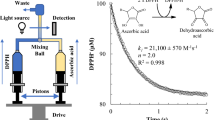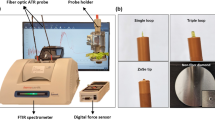Abstract
There is growing interest in measuring the antioxidant status of plant tissues. This protocol describes the oxygen radical absorbance capacity (ORAC) assay, which measures antioxidant inhibition of peroxyl radical–induced oxidations and is a measure of total antioxidant capacity. The assay is performed in a microplate and is assessed with a 96-well multi-detection plate reader. Total antioxidant capacity of 64 experimental samples can easily be analyzed in 1 d. This assay is presented along with rapid assays for total phenolic content and total ascorbate content. Overall, these assays provide a general diagnostic tool of the antioxidant capacity in leaf tissue extracts.
This is a preview of subscription content, access via your institution
Access options
Subscribe to this journal
Receive 12 print issues and online access
$259.00 per year
only $21.58 per issue
Buy this article
- Purchase on Springer Link
- Instant access to full article PDF
Prices may be subject to local taxes which are calculated during checkout


Similar content being viewed by others
References
Asada, K. & Takehashi, M. Production and scavenging of active oxygen in photosynthesis. In Photoinhibition (eds. Kyle, D.J., Osmond, C.B. & Arntzen, C.J.) 227–287 (Elsevier, Amsterdam, The Netherlands, 1987).
Finkel, T. & Holbrook, N.J. Oxidants, oxidative stress and the biology of aging. Nature 408, 239–247 (2000).
Bolwell, G.P. et al. The apoplastic oxidative burst in response to biotic stress in plants: a three-component system. J. Exp. Bot. 53, 1367–1376 (2002).
Mittler, R. Oxidative stress, antioxidants and stress tolerance. Trends Plant Sci. 7, 405–410 (2002).
Neill, S., Desikan, R. & Hancock, J. Hydrogen peroxide signaling. Curr. Opin. Plant Biol. 5, 388–395 (2002).
Polle, A. Dissecting the superoxide dismutase-ascorbate-glutathione-pathway in chloroplasts by metabolic modeling. Computer simulations as a step towards flux analysis. Plant Physiol. 126, 445–462 (2001).
Carol, R.J. & Dolam, L. The role of reactive oxygen species in cell growth: lessons from root hairs. J. Exp. Bot. 57, 1829–1834 (2006).
Pei, Z.M. et al. Calcium channels activated by hydrogen peroxide mediate abscisic acid signaling in guard cells. Nature 406, 731–734 (2000).
De Gara, L., de Pinto, M.C. & Tommasi, F. The antioxidant systems vis-a-vis reactive oxygen species during plant–pathogen interaction. Plant Physiol. Biochem. 41, 863–870 (2003).
Desikan, R., A-H-Mackerness,, S., Hancock, J.T. & Neill, S.J. Regulation of the Arabidopsis transcriptome by oxidative stress. Plant Physiol. 127, 159–172 (2001).
Noctor, G. & Foyer, C.H. Ascorbate and glutathione: keeping active oxygen under control. Annu. Rev. Plant Physiol. Plant Mol. Biol. 49, 249–279 (1998).
Dat, J. et al. Dual action of the active oxygen species during plant stress responses. Cell. Mol. Life Sci. 57, 779–795 (2000).
Desikan, R., Hancock, J. & Neill, S. Reactive oxygen species as signaling molecules. In Antioxidants and Reactive Oxygen Species in Plants (ed. Smirnoff, N.) 169–196 (Blackwell Publishing, Oxford, UK, 2005).
Larson, R.A. The antioxidants of higher plants. Phytochem. 27, 969–978 (1988).
Ghisseli, A., Serafini, M., Natella, F. & Scaccini, C. Total antioxidant capacity as a tool to assess redox status: critical view and experimental data. Free Radic. Biol. Med. 29, 1106–1114 (2000).
Blokhina, O., Virolainen, E. & Fagerstedt, K.V. Antioxidants, oxidative damage and oxygen deprivation stress: a review. Ann. Bot.(Lond) 91, 179–194 (2003).
Huang, M. & Guo, Z. Responses of antioxidative system to chilling stress in two rice cultivars differing in sensitivity. Biol. Plant. 49, 81–84 (2005).
Nayyar, H. & Gupta, D. Differential sensitivity of C3 and C4 plants to water deficit stress: association with oxidative stress and antioxidants. Environ. Exp. Bot. 58, 106–113 (2006).
Scebba, F., Pucciarelli, I., Soldatini, G.F. & Ranieri, A. O3-induced changes in the antioxidant systems and their relationship to different degrees of susceptibility of two clover species. Plant Sci. 165, 583–593 (2003).
Huang, D., Ou, B., Hampsch-Woodill, M., Flanagan, J.A. & Prior, R.L. High throughput assay of oxygen radical absorbance capacity (ORAC) using a multichannel liquid handling system coupled with a microplate fluorescence reader in 96-well format. J. Agric. Food Chem. 50, 4437–4444 (2002).
Cao, G. & Prior, R.L. Measurement of oxygen radical absorbance capacity in biological samples. Methods Enzymol. 299, 50–62 (1999).
Ghisseli, A., Serafini, M., Maiani, G., Assini, E. & Ferro-Luzzi, A. A fluorescence-based method for measuring total plasma antioxidant capability. Free Radic. Biol. Med. 18, 29–36 (1995).
Glazer, A.N. Phycoerythrin fluorescence-based assay for reactive oxygen species. Methods Enzymol. 186, 161–168 (1990).
Miller, N.J., Rice-Evans, C., Davies, M.J., Gopinathan, V. & Milner, A. A novel method for measuring antioxidant capacity and its application to monitoring the antioxidant status in premature neonates. Clin. Sci. (Lond) 84, 407–412 (1993).
Wayner, D.D., Burton, G.W., Ingold, K.U. & Locke, S. Quantitative measurement of the total, peroxyl radical-trapping antioxidant capability of human blood plasma by controlled peroxidation. The important contribution made by plasma proteins. FEBS Lett. 187, 33–37 (1985).
Prior, R.L., Wu, X. & Schaich, K. Standardized methods for the determination of antioxidant capacity and phenolics in foods and dietary supplements. J. Agric. Food Chem. 53, 4290–4302 (2005).
Ainsworth, E.A. & Gillespie, K.M. Estimation of total phenolic content and other oxidation substrates in plant tissues using Folin-Ciocalteu reagent. Nat. Protoc. 2, 875–877 (2007). doi: 10.1038/nprot.2007.102 (2007).
Gillespie, K.M. & Ainsworth, E.A. Measurement of reduced, oxidized and total ascorbate content in plants. Nat. Protoc. 2, 871–874 (2007). doi: 10.1038/nprot.2007.101 (2007).
Grace, S.C. Phenolics as antioxidants. In Antioxidants and Reactive Oxygen Species in Plants (ed. Smirnoff, N.) 141–168 (Blackwell Publishing, Oxford, UK, 2005).
Acknowledgements
This research was supported by the Office of Science (BER), U.S. Department of Energy, Grant no. DE-FG02-04ER63849.
Author information
Authors and Affiliations
Corresponding author
Ethics declarations
Competing interests
The authors declare no competing financial interests.
Rights and permissions
About this article
Cite this article
Gillespie, K., Chae, J. & Ainsworth, E. Rapid measurement of total antioxidant capacity in plants. Nat Protoc 2, 867–870 (2007). https://doi.org/10.1038/nprot.2007.100
Published:
Issue Date:
DOI: https://doi.org/10.1038/nprot.2007.100
This article is cited by
-
Long-Term Effects of Cold Atmospheric Plasma-Treated Water on the Antioxidative System of Hordeum vulgare
Journal of Plant Growth Regulation (2023)
-
Physiological and morphological effects of a marine heatwave on the seagrass Cymodocea nodosa
Scientific Reports (2022)
-
Beneficial effects of gamma-irradiation of quinoa seeds on germination and growth
Radiation and Environmental Biophysics (2022)
-
Characterization of alginate extracted from Sargassum latifolium and its use in Chlorella vulgaris growth promotion and riboflavin drug delivery
Scientific Reports (2021)
-
Thiourea and hydrogen peroxide priming improved K+ retention and source-sink relationship for mitigating salt stress in rice
Scientific Reports (2021)
Comments
By submitting a comment you agree to abide by our Terms and Community Guidelines. If you find something abusive or that does not comply with our terms or guidelines please flag it as inappropriate.



